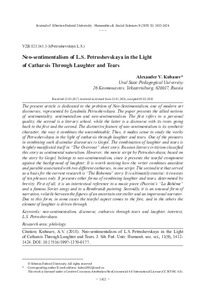Показать сокращенную информацию
Neo-sentimentalism of L.S. Petrushevskaya in the Light of Catharsis Through Laughter and Tears
| Автор | Kubasov, Alexander V. | en |
| Автор | Кубасов, А.В. | ru_RU |
| Дата внесения | 2018-03-01T04:14:28Z | |
| Дата, когда ресурс стал доступен | 2018-03-01T04:14:28Z | |
| Дата публикации | 2018 | |
| URI (для ссылок/цитирований) | https://elib.sfu-kras.ru/handle/2311/70382 | |
| Аннотация | The present article is dedicated to the problem of Neo-Sentimentalism, one of modern art discourses, represented by Lyudmila Petrushevskaya. The paper presents the allied notions of sentimentality, sentimentalism and neo-sentimentalism. The first refers to a personal quality, the second is a literary school, while the latter is a discourse with its roots going back to the first and the second. The distinctive feature of neo-sentimentalism is its synthetic character, the way it combines the uncombinable. Thus, it makes sense to study the works of Petrushevskaya in the light of catharsis through laughter and tears. One of the pioneers in combining such dissimilar discourses is Gogol. The combination of laughter and tears is brightly manifested itself in “The Overcoat” short story. Russian literary criticism classified this story as sentimental naturalism. However, the movie script by Petrushevskaya, based on the story by Gogol, belongs to neo-sentimentalism, since it presents the tearful component against the background of laughter. It is worth noticing how the writer combines anecdote and parable associated with two different catharses, in one script. The second text that served as a basis for the current research is “The Bohemia” story. It is ultimately concise: it consists of ten phrases only. It presents other forms of combining laughter and tears, determined by brevity. First of all, it is an intertextual reference to a music piece (Puccini’s “La Bohème” and a famous Soviet song) and to a Rembrandt painting. Secondly, it is an unusual form of narration, volatile between the figures of an uncertain storyteller and an impersonal narrator. Due to this form, in some cases the tearful aspect comes to the fore, and in the others the element of laughter is driven through | en |
| Аннотация | Первое рассматривается как личностное качество, второе – как литературное направление, а третье – как дискурс, корнями связанный с первым и вторым понятиями. Отличительной чертой неосентиментализма признается его синтетичность, соединение, казалось бы, несоединимого. Поэтому логично, что творчество Петрушевской рассматривается сквозь призму двух типов катарсиса: слезного и смехового. Одним из литературных первооткрывателей такого соединения разнородных дискурсов является Гоголь. Соединение смеха и слез очевидно проявилось в его повести «Шинель». Это произведение отечественное литературоведение относило к сентиментальному натурализму. Киносценарий по повести Гоголя, написанный Петрушевской, – произведение неосентиментализма, так как в нем слезное начало подается на смеховом фоне. Важно и то, что писательница соединяет в сценарии два разнородных жанра: анекдот и притчу, которые тоже связаны с разнородными катарсисами. Вторым художественным текстом для исследования поставленной проблемы выбран рассказ «Богема». Он предельно лапидарен: состоит из десяти фраз. В нем представлены другие формы соединения смеха и слез, обусловленные краткостью. Во-первых, это интертекстуальные связи, отсылающие читателя к музыкальным произведениям (опера Пуччини «Богема» и известная советская песня), к известной картине Рембрандта. Во-вторых, это необычная форма повествования, которая колеблется между фигурой ненадежного рассказчика и безличным повествователем. Эта форма позволяет в одних случаях актуализировать слезное начало, а в других – смеховое | ru_RU |
| Язык | en | en |
| Издатель | Сибирский федеральный университет. Siberian Federal University | en |
| Тема | neo-sentimentalism | en |
| Тема | discourse | en |
| Тема | catharsis through tears and laughter | en |
| Тема | intertext | en |
| Тема | L.S. Petrushevskaya | en |
| Тема | неосентиментализм | ru_RU |
| Тема | дискурс | ru_RU |
| Тема | слезный и смеховой катарсисы | ru_RU |
| Тема | интертекст | ru_RU |
| Тема | Л.С. Петрушевская | ru_RU |
| Название | Neo-sentimentalism of L.S. Petrushevskaya in the Light of Catharsis Through Laughter and Tears | en |
| Альтернативное название | Неосентиментализм Л.С. Петрушевской сквозь призму слезного и смехового катарсисов | ru_RU |
| Тип | Journal Article | en |
| Контакты автора | Kubasov, Alexander V.: Ural State Pedagogical University 26 Kosmonavtov, Yekaterinburg, 620017, Russia; kubas2002@mail.ru | en |
| Контакты автора | Кубасов, А.В.: Уральский государственный педагогический университет Россия, 620017, Екатеринбург, пр. Космонавтов, 26 | ru_RU |
| Страницы | 1412-1424 | |
| Журнал | Журнал Сибирского федерального университета. Гуманитарные науки. Journal of Siberian Federal University. Humanities & Social Sciences;2018 | en |

